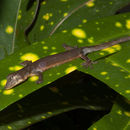en
names in breadcrumbs


Philippine lizards of the family Gekkonidae comprise 49 species (Taylor, 1915, 1922; Brown and Alcala, 1978) in 10 genera: Gehyra (1), Gekko (13), Hemidactylus (5), Hemiphyllodactylus (2), Lepidodactylus (6), Luperosaurus (8), Ptychozoon (1), Pseudogekko (4), and Cyrtodactylus (9), (Brown et al., 2007, 2010a, 2011; Welton et al., 2009, 2010a, 2010b; Zug, 2011). An amazing percentage of these species are endemic to the Philippines archipelago (roughly 85%; Brown et al., 2011). Several of the recently described gekkonids in the Philippines were discovered only recently as part of ongoing surveys around the archipelago. Recent phylogenetic studies focused on Philippine gekkonids (Siler et al., 2010; Welton et al., 2010a,b) have resulted in the observation of high levels of genetic diversity among populations of widespread species, an indication that the country's gecko diversity may still be greatly underestimated.
The genus Pseudogekko presently contains four species, all endemic to the Philippine islands (Pseudogekkobrevipes, Pseudogekkocompressicorpus, Pseudogekkosmaragdinus, Pseudogekkointermedium). Species in this genus are easily diagnosed from all other Philippine gecko species due to their long, slender, delicate body forms. All species appear to prefer arboreal habitats and are often found on leaves of saplings, trees, or aerial ferns. Specimens of most species remain rare in collections. Body coloration is quite variable both between species and between island populations within species, with Pseudogekko smaragdinustaking the prize for the most brilliant color pattern (neon yellow to green body). Although the diversity in the genus is currently recognized to be low, it is quite possible that widespread species are actually complexes of morphologically similar but distinct lineages.
Pseudogekko brevipescan be distinguished from congeners by the following combination of characters: (1) terminal scansors undivided, 2-4 subterminal scansors divided on all digits except digit I; (2) dorsal dark spots absent or sparse; (3) enlarged preanal and femoral pores in males 10-16; (4) Toe-IV scansors 14-18; and (5) supralabials 12-17. Characters and character states from Brown and Alcala (1978).
This species is recognized to occur on the islands of Samar, Negros, Bohol, and Cebu in the Central Philippines.
Recorded from both depterocarp and submontane forest at elevations from about 300 to 1,100 meters. The normal habitat is the leaf axils of aerial ferns and Pandanus in the forest on Negros. (Text taken from Brown and Alcala, 1978)
Mindanao and Visayan (Central) Pleistocene Aggregate Island Complexes (PAIC; Brown and Diesmos, 2002).
Eggs and Hatchlings: Several hatchlings measure 16 to 21 mm in snout-vent length. Eggs have been collected from a leaf axil in a Pandanus a coconut husk, and attached to a rotting branch on the forest floor. (Text taken from Brown and Alcala, 1978)
SVL 40-54 mm (Brown and Alcala, 1978)
Samar Island, Philippines; type in the Senckenberg Museum; SM 8988
Pseudogekko brevipes, also known as Luzon false gecko or orange-spotted smooth-scaled gecko is a species of geckos. It is endemic to central Philippines, where it is found on several islands in dipterocarp and submontane forest at elevations of 300 to 1100 m above sea level.[1]
Pseudogekko brevipes, also known as Luzon false gecko or orange-spotted smooth-scaled gecko is a species of geckos. It is endemic to central Philippines, where it is found on several islands in dipterocarp and submontane forest at elevations of 300 to 1100 m above sea level.